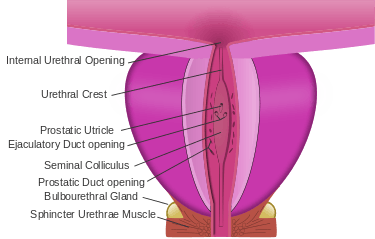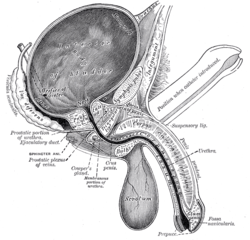Membranous urethra
| Membranous urethra | |
|---|---|
 The male urethra laid open on its anterior (upper) surface. (Membranous part labeled at upper right.) | |
 Dissection of the prostate showing the prostatic and membranous portions of the urethra (unlabeled) | |
| Details | |
| Latin |
Pars intermedia urethrae masculinae, pars membranacea urethrae masculinae |
The intermediate part of male urethra (membranous portion) is the shortest, least dilatable, and, with the exception of the external orifice, the narrowest part of the canal.
It extends downward and forward, with a slight anterior concavity, between the apex of the prostate and the bulb of the urethra, perforating the urogenital diaphragm about 2.5 cm below and behind the pubic symphysis.
The hinder part of the urethral bulb lies in apposition with the inferior fascia of the urogenital diaphragm, but its upper portion diverges somewhat from this fascia: the anterior wall of the membranous urethra is thus prolonged for a short distance in front of the urogenital diaphragm; it measures about 2 cm in length, while the posterior wall which is between the two fasciæ of the diaphragm is only 1.25 cm long.
The membranous portion of the urethra is completely surrounded by the fibers of the Sphincter urethrae membranaceae.
In front of it the deep dorsal vein of the penis enters the pelvis between the transverse ligament of the pelvis and the arcuate pubic ligament; on either side near its termination are the bulbourethral glands.
Additional images
 Structure of the penis
Structure of the penis Vertical section of bladder, penis, and urethra.
Vertical section of bladder, penis, and urethra.
References
This article incorporates text in the public domain from the 20th edition of Gray's Anatomy (1918)
External links
- Anatomy photo:43:08-0102 at the SUNY Downstate Medical Center - "The Female Pelvis: The Urethra"
- Anatomy photo:44:06-0103 at the SUNY Downstate Medical Center - "The Male Pelvis: The Urethra"
- MedEd at Loyola Grossanatomy/dissector/practical/pelvis/pelvis11.html